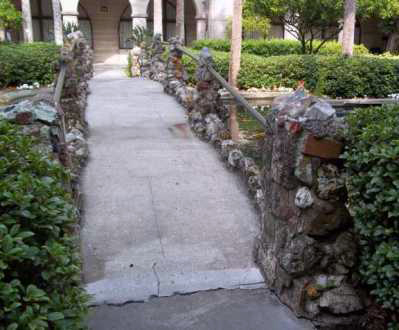More on the Native American conversation:
Ethel Bussy, in her 1960 book History of Margaretville and Surrounding Area, noted that “In 1949, Willard Sanford (former Village Historian) took a piece of stone from the site of the ancient Indian village of Pakatakan near Arkville and it was sent by express to the Lightner Museum at St. Augustine, Florida. The stone was to be engraved with the name of the donor and the site from which it was taken and was to be inserted into a stone bridge being built near the museum. The bridge was to be made up of stones from each battlefield and historical site in the US.”
Ms Lawrie passed along this photo of the bridge, with the Pakatakan rock embedded somewhere. The whole story of the Native American village – whether it was indeed a settlement, or a seasonal camp, and precisely where it was located — remains a topic for debate and wonder.

The bridge at Lightner Museum, with Pakatakan rock embedded, somewhere.
